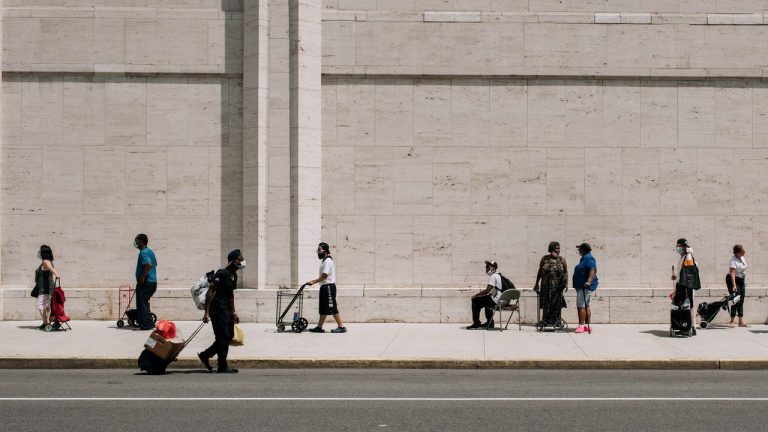The higher COVID-19 death rate for Black people is often blamed on preëxisting health conditions, but that’s only part of the story. Blacks have asthma at a rate of 9.2 per cent, compared with eight per cent of whites; 16.8 per cent of Blacks have diabetes, compared with ten per cent of whites (Reggie Smith has diabetes); 40.3 per cent have hypertension compared with 27.8 per cent of whites. Moreover, Blacks are sixty per cent more likely not to have health insurance, making it harder for them to get treatment for COVID-19 and other illnesses: 12.3 per cent of Blacks are uninsured, compared with 7.5 per cent of whites.
“The issue of preëxisting conditions doesn’t just happen,” Hamilton said. “There’s a whole political economy that’s made Blacks more vulnerable to having preëxisting conditions.” He cited such factors as lack of medical coverage, poor living conditions, and environmental degradation. Another factor is that Black people disproportionately live in apartment complexes (where it is easier for the virus to spread), rather than single-family homes. According to a study by the Economic Policy Institute, twenty-nine per cent of Blacks live in buildings with five or more units, which is twice the rate for whites; fifty-four per cent of Blacks live in single-unit dwellings, compared with seventy-four per cent of whites.
Additionally, a disproportionate percentage of Black people hold jobs that make them essential workers. Blacks represent 11.9 per cent of the total workforce, but they make up 14.2 per cent of the workforce at grocery, convenience, and drug stores; twenty-six per cent in public transit; 18.2 per cent in trucking, warehouse, and mail service; 17.5 per cent in health care; and 19.3 per cent in child care and social services. Essential workers often say that they are not adequately protected. In April, Maya Smith, an African-American cashier at a Walmart in New Orleans, told New Orleans Public Radio that her boss didn’t allow workers to wear masks, because some shoppers thought it meant the workers were infected, and Jennifer Suggs, an African-American Walmart cashier in South Carolina, said, “We’re not essential. We’re sacrificial. I will be replaced if I die from this. I don’t have a mask or gloves. The only thing I have is a stupid blue vest.” African-Americans also face a higher likelihood of being infected by the coronavirus, because a lower percentage of them can work from home—19.7 per cent of Blacks, compared with 29.9per cent of whites (and 16.2 per cent of Hispanics).
“Either you lose your job, or you stay on a job where you have much greater probability of being subjected to the disease,” William A. Darity, Jr., a professor of public policy at Duke University, told me. “If Black folks had a higher level of wealth, they would have had a greater opportunity to exit from these jobs in which they were in jeopardy.”
A new book, “From Here to Equality, Reparations for Black Americans in the Twenty-First Century,” which Darity co-authored with A. Kirsten Mullen, details the racial disparities in wealth and its causes. The authors write that while Black people make up thirteen per cent of the American population, they own just 2.5 per cent of the wealth. The median wealth of white households was $171,000 in 2016, ten times that of Black households. Darity and Mullen told me that the average net worth for white households is $933,000, but for Black households it is just $138,000. Black heads of households with a college degree, they point out, have two-thirds the median net worth of white heads of households who never finished high school.
In their book, Darity and Mullen attribute the vast disparity in wealth to the legacy of slavery and to myriad racial injustices since abolition, starting with the federal government’s failure to make good on its promise to give freed slaves forty acres of land. Meanwhile, the U.S. enacted vast economic programs that aided whites, such as the Homestead Act of 1862, which gave a hundred and sixty acres to a million and a half families, the overwhelming majority of which were white. This provided assets that those families handed down to successive generations. Darity and Mullen argue that the failure to distribute forty acres to former slaves was a tremendous blow in holding back the accumulation of Black wealth; Lincoln approved the plan, and General William Tecumseh Sherman had announced it, but Lincoln’s successor, Andrew Johnson, overturned it. “That is the nest egg,” Mullen told me. “Had those Black folks been able to develop that land, maybe to leverage it to make other investments that they could have transferred intergenerationally, [it] quite likely could have altered the present moment. But they didn’t have a chance to do that.”





